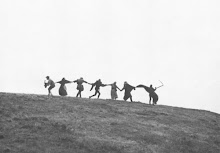December 8, 1542 - Februry 8, 1587: Age 44
Mary Stuart became Queen of Scotland at just six days old. Her father died of cholera, leaving no male heirs. She was just nine months old at her coronation; someone had to prop her up while the heavy crown was lowered onto a velvet circlet on her head.
She was by nature impulsive, clever, kind, friendly, and compassionate; few of these qualities would be useful to her as a monarch. In another time, or another station in life, she would probably have lived to be a great and wise old lady, benefitting countless people with her warmth and intelligence. It was not to be.
She peaked early. Sent to France at five to marry the Dauphin, she had a happy childhood, getting the best education available and being a great favourite with the French court. At 16, her father-in-law died, making her Queen of France, but only for one year: her husband died in 1560, and she returned to Scotland, where she was still Queen. As the great-granddaughter of Henry VII of England, she was also next in line to the English throne after Elizabeth I, and here lay her greatest peril: as a Catholic, she was regarded by other Catholics as someone who would return England to the True Church if Elizabeth were to die without heir. This made her an enemy of the Queen of England, whether she liked it or not.
Meanwhile the Scotland she returned to was a dangerous and complicated place. She tried to make friends with her cousin Elizabeth, but was unsuccessful. Elizabeth, the canny politician, was infuriated by her bad decisions, which included marrying twice for love, both terrible men who abused and betrayed her, as well as abdicating the throne in favour of her three-year-old son, James. A virtual prisoner in her own country, she fled to England, throwing herself on Elizabeth's mercy. Elizabeth had none to spare: her presence was an acute danger to the Queen and to the stability of the country, and an embarrassment as well. She was immediately imprisoned, and for nearly 18 years Elizabeth fretted about what to do with her.
In the end, Elizabeth's own secret service were able to entrap Mary into plotting, or at least appearing to plot, to escape and take the throne. She was tried, found guilty, and condemned to death.
She took it all with grace and calm. When she mounted the scaffold, her executioners knelt before her and asked forgiveness, to which she replied "I forgive you, for you are about to end my troubles!" They helped her remove her black outer gowns, revealing a deep red chemise underneath, a dramatic reference to the liturgical colour of martyrdom in the Catholic Church. She smiled a little and joked, "never have I had such assistants to disrobe me, and never have I put off my clothes before such a company."
She was blindfolded, knelt down, positioned her head on the block, and stretched out her arms behind her. It took two strokes of the ax to behead her; the first blow missed her neck and hit her on the back of her head, and she was heard to whisper "Sweet Jesus". The second blow severed her neck, but the executioner had to saw back and forth a bit to cut the last bit of sinew. Then, as tradition dictated, he grasped her head by her hair to hold it aloft, but he was left holding a wig while the head itself fell back down and rolled away. Mary's auburn tresses had been fake for years; her actual hair was short and gray. It is said that as her head lay on the stage after this, the lips were still moving in prayer for 15 minutes after it was severed.
At this point, to everyone's great surprise, her little dog suddenly emerged from under her skirts and circled her head, crying anxiously. Covered in blood, he refused to be parted from her, and had to be taken away forcibly by her maids.
In a very real way, Mary was a martyr, but she was killed by Catholics as well as Protestants. Although she herself probably harboured no ambitions for the English throne, her existence made her a flashpoint for Catholic fanaticism, whose interest in her guaranteed that her death become a political necessity for the English sovereign and government.
Sources:
Wikipedia,
The Execution of Mary Queen of Scots
 Patrick Hamilton came from good stock: he was the great-grandson of King James II of Scotland. He joined the clergy and set off for Paris to study, the first step on the way to a comfortable life in the Church, but it didn't work out that way. In Paris, the writings of Martin Luther were being discussed, and it was here that the young man first heard the Protestant doctrine. After Paris, he went to Leuven, Erasmus' hotbed of heresy.
Patrick Hamilton came from good stock: he was the great-grandson of King James II of Scotland. He joined the clergy and set off for Paris to study, the first step on the way to a comfortable life in the Church, but it didn't work out that way. In Paris, the writings of Martin Luther were being discussed, and it was here that the young man first heard the Protestant doctrine. After Paris, he went to Leuven, Erasmus' hotbed of heresy.












.jpg)






















